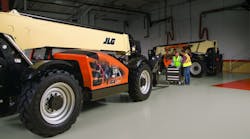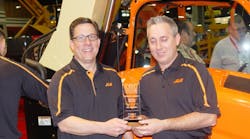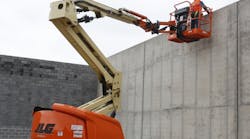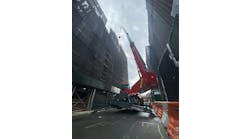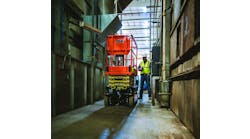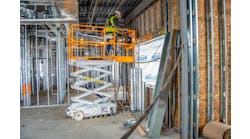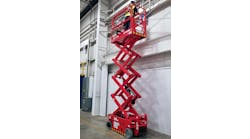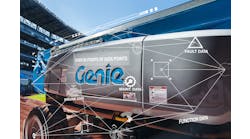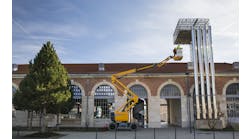Interview with JLG’s Corey Raymo: Continuing to Utilize Technology
RER interviews JLG’s global product director – booms, about continuing technological advances in low-level access, the 60- and 80-foot core of the fleet and hybrid technologies, the growth of the aerial market and important key safety programs.
RER: What are the most important technological developments in aerial work platforms in the past year or so?
Raymo: JLG recently announced that our revolutionary SkyGuard system will be standard on all booms globally after January 2017. When activated, JLG’s SkyGuard system stops all functions in use at the time, then temporarily reverses most functions that were in use when the system was activated. This reverse functionality is the only feature of its kind in the market.
Operator safety is the number one priority for us at JLG and the driver behind many of our product innovations, and is becoming more and more of a focus for our customers in the industry.
In addition, we are seeing the ability to go higher, more efficiently than in the past due to new technologies available. At Bauma 2016 JLG previewed the world’s tallest and farthest reaching articulating boom lift, the 1500AJP, with a working envelope of more than 74,000 cubic meters of reachable space. The 1500AJP, which will be available for shipment to customers in early 2017, allows operators to reach more work space and take more materials with them than any other articulating boom lift. In addition, the 1500AJP offers 1000 lb. platform capacity that is available throughout the vast majority of the working envelope. Technology was a key enabler to allow JLG to develop this completely new version of its 150-foot articulating boom that has improved performance specs, along with improved transportability due to its more compact transport size.
Other key technological developments we are seeing in the industry and on JLG AWPs are more fuel efficient engines due to fully variable/on-demand engine RPMs, use of electronics instead of hydraulics to improve comfort and diagnostics, and use of AC Drive motor technologies to improve overall efficiencies and lower total cost of ownership for customers.
What do you expect in the coming year?
We will continue to focus on total cost of ownership, safety and innovation in regards to product development and service. This is in line with where we see our customers moving their focus and needs to as they become more developed in their business models, and as the industry continues to put a focus on safety on the job site and environmental sustainability.
What are the most compelling developments in the low-level access area? Is this a growing market segment?
Low-level access is a growing area. JLG acquired Power Towers Ltd., a leading low level access equipment manufacturer based in Leicester, UK, in 2015 to strengthen our existing portfolio of low level access lifts.
We debuted our new non-powered vertical lifts – the EcoLift 50 and EcoLift 70 – at The Rental Show 2016. These all-new, low-level access lifts are virtually maintenance free, thanks to a patented stored power lift/lower system that requires no batteries, hydraulics, oil, or controls.
The EcoLift series is a game changer in the rental industry because of its robust and rental-tough design. Extremely easy to operate and environmentally friendly, the lifts provide working heights of 11 and 13 feet respectively by simply turning a handle to move the lift up or down. What’s more, the lifts’ lightweight design makes it easy to push them around a job site. They are rated for 330 pounds, leaving room for materials and tools to boost productivity. And, because there are no hydraulics or motors involved, both of the eco-friendly lifts operate quietly, making them a preferred piece of equipment for finish work on construction sites or even as maintenance access equipment in schools, hospitals, and other institutions. Measuring just under 28 inches in width, the lifts easily roll through standard doorways on caster wheels and maneuver around all areas of a facility.
Also announced at The Rental Show 2016, a new push-around mast lift — the JLG 830P — uses hydraulics to lift operators to a working height of 14 feet and offers workers a generous 29 by 39-inch platform. Like the EcoLifts, the 830P features a lightweight design that makes it easy for operators to push the lift into position, and heavy-duty, auto-lock wheels on elevation provide a secure base.
All three of these units offer attractive alternatives to ladders and scaffolding. They give workers the ability to use both hands on the job rather than needing to maintain three points of contact.
Sum up what your company has done technologically recently that is unique.
In summary, JLG has leveraged technology across the board to improve the overall satisfaction of our customers. We have done this through product developments, but also through some of our services, like training.
Training is incredibly important to our industry. When operators are well trained and fully understand how to operate a machine safely, they help protect themselves and others on the jobsite. Speaking for JLG, we have an equipment simulator we introduced in October 2014. Some key features include:
- Powerful learning tool remotely accessible to registered students with any laptop.
- Simulates operation of the JLG 800S telescopic boom lift and the JLG G10 telehandler, and most recently the 1850SJ telescopic boom lift in a virtual environment that recreates the training center and proving grounds to scale.
- Offers three training sessions on each piece of equipment, including controls familiarization, and two operating scenarios (beginner level and more challenging tasks).
- Provides two views: operator’s perspective and a side view.
- All controls function as they do in the boomlift and telehandler.
- Map in corner of screen helps with navigation and identifying location of boom lift or telehandler.
- Features touch screen controls.
- Decreases the learning curve when operators first enter a lift or telehandler.
- We have also expanded our training center and added an all-new proving grounds course, which provides trainees with the opportunity for a hands-on learning experience that teaches driving and operating skills on telehandlers, scissor lifts, and booms in a safe, controlled environment.
Rear-sensing (detection) systems are also an innovation we are proud of introducing to our customers. This is optional in our newly redesigned JLG telehandlers, and is an industry first. The rearview camera with multipurpose display shows integrated electronic load charts, diagnostics, and analyzer functions. It gives operators extra confidence when backing up their telehandlers. JLG’s rear object detection system alerts operators of rear obstructions.
What is likely to be new at the 60, 80, and 100 foot levels?
These heights are primarily the “core” of the fleets, particularly the 60 and 80 foot machines. They have been established in the industry for quite a while now, and many models may still use designs and technologies from 15 or more years ago depending on the OEM. One very likely scenario we’ll continue to see is updating these core models and designs to use more modern designs and technologies. The AWPs will likely still do the same basic tasks of working at height, but we’ll likely see some newer technologies and possibly even some new capabilities to allow customers to access more work areas than ever before.
We have seen tremendous growth in the AWP segment. Still I’m sure there are some industries that are open for growth, and geographic regions where there is ample room for adoption of AWPs. What are some of your thoughts about this?
There are certainly geographical regions that have plenty of room for growth both from an economic growth perspective and an adoption perspective. With respect to AWP adoption, we see key emerging market growth opportunities in areas like lesser developed regions of Asia and Latin America. In these regions, we still see a significant amount of scaffolding and ladder usage in areas that an AWP could be a better solution.
There have been great advances in safety in the aerial industry. What are some concerns in the safety arena?
When working at height, safety is always top of mind. That is why at JLG we are continuing to utilize technology to enhance our products, service, and training. Until job sites are accident free, operator safety will be a concern. This not only applies to safety in AWPs, but overall safety on job sites that AWPs are used on. AWPs, the environment and surroundings, and other equipment all interact on a job site, so we can’t just consider each piece of equipment individually. We need to stay focused on a holistic approach to work site safety to get us to accident-free work sites.
How would you assess technological advancements in electric units, hybrids and alternative fuels?
Hybrid technology continues to evolve in the AWP industry. Some of the first hybrids were introduced in the AWP industry about 20 years ago. JLG’s first look at this market involved testing an electric boom lift hauling a gas-powered generator behind it to charge it. We see different approaches to hybrid systems, whether they are parallel or series hybrids, but we are also seeing developments within them. For example, advances in the underlying electrical technology like moving from DC to AC technology is advancing hybrid performance and efficiencies. In addition, we see regeneration coming into hybrids now and will see more in the future. Overall, electric and hybrids are at a pretty exciting time and still have some room for advancements in this industry.


